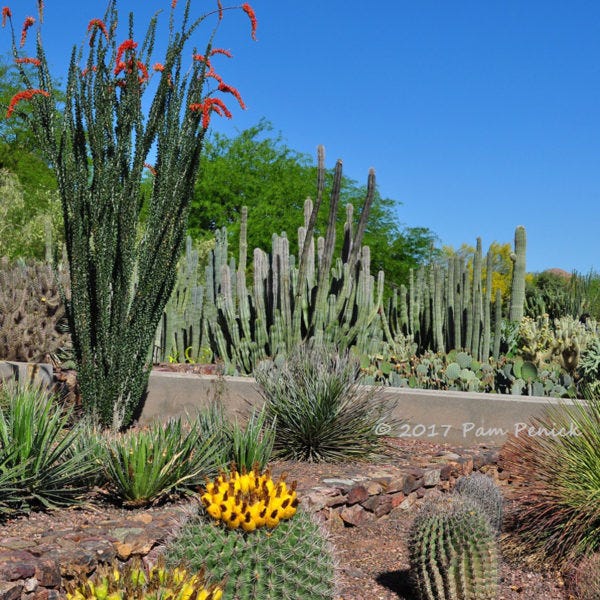Fantastical Flora at Desert Botanical Garden in Phoenix
by High Country Gardens

Plants Like You’ve Never Seen
If a faded, Old West panorama of a lonely cactus and dusty tumbleweeds comes to mind when you hear the words “desert garden,” book a trip right now to Desert Botanical Garden in Phoenix, Arizona. Awash with fantastical, Dr. Seussian plants—columnar and beach-ball-shaped cacti, jewel-box wildflowers, fleshy succulents, and flowering desert trees—DBG showcases plants like you’ve never seen from the Sonoran Desert and arid regions around the world. Founded nearly 80 years ago, in the 1930s, by farsighted Phoenix residents appreciative of the desert’s fragile beauty and concerned about its survival amid rapid development, the 140-acre garden today consists of 5 loop trails featuring distinct desert experiences, including wildflowers, a nature trail, desert living, and plants and people of the Sonoran Desert.
Enter the Botanic Garden Getaway and win a trip for two to the Botanic Garden of your choice!

Located in Papago Park, a landscape of slumping, rusty-red buttes resembling Jabba the Hutt, the garden is only 20 minutes from downtown Phoenix but seems a world away. Evocatively named species like organ pipe cactus, beavertail pricklypear, and teddy bear cholla cluster around giant saguaros that are hundreds of years old, their accordion-like flesh expanding with stored water after a rare rain. Crimson powder-puff flowers of Baja fairy duster dance alongside aloes’ tubular, orange flower spikes, and wildflowers paint the rocky soil in shades of purple, yellow, and pink in springtime.

Many plants sheath themselves with sun-shading spines and cottony hairs that incandesce in sunlight, giving them a haloed glow, especially in the low light of morning and evening. Richly painted stucco walls and bancos (built-in bench seating) in hot pink, terracotta red, olive green, and melon add Southwestern color and structure to the garden, as do lofty, barrel-vaulted shade structures of rusty steel, which protect tender cacti and succulents from sunburn (yes, even cacti can sunburn) and occasional frost.

A Bird-Watcher’s Paradise
Birders, bring your binoculars and cameras! Named one of the “birdiest” botanical gardens by Birds & Blooms Magazine, Desert Botanical Garden attracts hummingbirds, Gila woodpeckers, quail, cactus wrens, roadrunners, western screech owls, and many other permanent and migratory species. On Monday mornings, you can tour the garden with an expert birder and check off birds on your life list. During the hottest months of summer and early fall, hit the garden first thing in the morning or in early evening to enjoy cooler temperatures, more wildlife activity, and better light for photos. Be desert smart: wear a hat, drink plenty of water, and avoid the midday sun. Helpfully, the garden keeps long hours year-round, opening daily at 8 am and closing at 8 pm. Become a member, and you can enter as early as 7 am on Wednesdays and Sundays. Or, in summer, grab a flashlight and tour the garden after hours (7 to 10 pm on Thursdays and Saturdays) to experience the desert in the coolness of night.

Spring Wildflower Season at Desert Botanical Garden
Perhaps the best time of year to visit is during spring wildflower season, February through May, when the gray-greens of the desert are suddenly suffused, Kansas-to-Oz style, by Technicolor flowering. Stroll the Desert Wildflower Loop to see pink spires of penstemon, sun-bright damianita and brittlebush, and lake-blue lupines softening the sword-like architecture of steel-blue agaves and columns of bristling cacti. April, when green-trunked palo verde trees dazzle with canary-yellow flowers and strew the ground with golden confetti, is especially fine. When you need to refuel, stop for lunch or dinner at Gertrude’s, the garden’s farm-to-table restaurant, and enjoy a glass of wine on the patio while you wait for a table. You can also make a reservation. As the sun sinks behind the red hills and the sky glows with the rosy hues of cactus flowers, you’ll be making plans for a return visit to this exceptional garden.
Pam Penick is author of The Water-Saving Garden and Lawn Gone! and publisher of the blog Digging. She lives and gardens in Austin, Texas.
© All articles are copyrighted by High Country Gardens. Republishing an entire High Country Gardens blog post or article is prohibited without written permission. Please feel free to share a short excerpt with a link back to the article on social media websites, such as Facebook and Pinterest.
